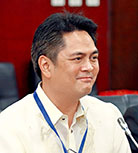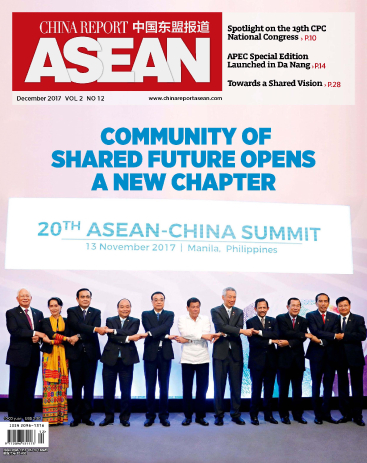
Jose Ruperto Martin Marfori Andanar, Secretary of the Presidential Communications Operations Office of the Philippines.
Since its founding half a century ago, ASEAN has continuously expanded and evolved into a strong community that plays a pivotal role in maintaining regional peace and stability as a representative force in the advancement of global multi-polarization. China and ASEAN established dialogue relations in 1991, and have ever since strived to seek development through cooperation, with mutual political trust enhanced and tangible accomplishments achieved.
As the rotating chair of ASEAN this year, the Philippines has made unremitting efforts to elevate the China-ASEAN relationship to a higher level. While leading a media delegation on a visit to China, Jose Ruperto Martin Marfori Andanar, Secretary of the Philippines’ Presidential Communications Operations Office, sat down for an exclusive interview with China Report ASEAN.
>> China Report ASEAN: Mr. Secretary, you and your delegation have visited various media organizations in China and had talks with Chinese media professionals. Could you please tell us your impression of the Chinese media industry overall?
Secretary Andanar: First of all, I would like to extend my gratitude to President Xi Jinping, and to the officials of the Chinese government for actively seeking our cooperation and asking us to act on the agreements and scholarships that the Chinese government has offered to the Philippine state media.
We have learned a great deal of valuable information and techniques in managing our television, radio and online media. At China International Publishing Group (CIPG), we were inspired to establish a similar publishing organization within the Philippine government.
It is very important for me to mention that visiting Chinese state-run media organizations gave us the idea that history is very important. In all of these organizations, there is an area or hall illustrating company history. As they say, you cannot move forward if you do not know your history. The history of an organization should serve as inspiration for future generations to further develop an organization.
We also learned more about Chinese international politics and international relations that have grown from the times of Chairman Mao Zedong to the current leadership of President Xi Jinping. Now, we have a better grasp of the issues that are confronting the Chinese government, which will make it easier for us in the media to help our citizens understand what challenges the Chinese government is facing.
>> China Report ASEAN: Last year, the Presidential Communications Operations Office (PCOO) of the Philippines and the State Council Information Office (SCIO) of China signed a memorandum of understanding on media cooperation. What are your plans to deepen bilateral cooperation in this field?
Secretary Andanar: The MOU is a people-to-people and cultural initiative carried out by the governments of both countries. We’ve learned about the culture and history of the SCIO, and will also learn from its technology, management and development strategies.
China is open to the Philippines coming here to produce documentaries and other forms of communication for our people to understand what China is currently doing. China also encourages its citizens to travel to the Philippines to learn about our culture. Now that we have signed the MOU, we will work with the Chinese media to share content from both sides. Establishing such a communication base is imperative for the producer and the audience to speak to one another, and for one country to speak to another. Once the communication is open, dynamic and transparent, ties between both countries will be strengthened, and an environment of mutual trust will be created.
>> China Report ASEAN: Media connectivity and cooperation is also part of China's Belt and Road Initiative (BRI). What do you think of the development of China and ASEAN under the cooperation framework of the BRI?
Secretary Andanar: From our own perspectives in the Philippines, the BRI proposed by China is inviting many countries around the world to develop together, particularly in terms of economics and trade. It lends a huge opportunity for our country to catch up in our region, and finally become a “tiger economy”.
The BRI is a realization of the dream to relaunch, and show people everywhere the old Silk Road and the ancient Maritime Silk Road linking China with the rest of the world. The initiative is set to reshape the development of the global economy. The Philippines embraces China's BRI, and has established a deeper, more cooperative and more dynamic relationship with the Chinese government. The Philippines lies in the middle of the Maritime Silk Road, between China and the rest of the world. It is of great interest to us to deepen cooperation with China, not only as neighbors, but also as brothers.
This year, the Philippines serves as the rotating chair of ASEAN, which is celebrating its 50th anniversary. ASEAN is growing as a regional organization that is very united, and all its members respect each other's political nuances and uphold the spirit of non-indifference. As an ally of China and the chair of ASEAN, the Philippines is working hard to promote the crafting of multilateral agreements. We will also show other ASEAN countries that China is here to share its experiences, and to ensure that prosperity is not only for the Chinese, but for all.
>> China Report ASEAN: The Philippines is a friendly neighbor and a major partner in Belt and Road construction. What do you see as the future of the China-ASEAN relationship based on bilateral cooperation in various fields for the building of a community of shared future?
Secretary Andanar: China and ASEAN countries are good neighbors and good friends, sharing geographical affinity and cultural bonds. We are also important partners in Belt and Road construction. China is now the world's second largest economy, and I hope that China's ruling party will lead the country in playing an even more active role in regional, and even global, economic structure. We all know that China used to be described as a sleeping giant, which has now awakened, pondering how to play a more prominent role on the global stage.
As the Philippine-China relationship has returned to the path of sound and comprehensive development, bilateral cooperation is in full swing in various areas. I have full confidence in future cooperation between the two sides, especially in infrastructure construction. The Philippines has gained from the more than US$24 billion that China has committed to our country in our economic development, and further billions of dollars are coming from the private-public partnerships between the Philippine government and private Chinese companies.
The PCOO has beefed up its reporting efforts to help the public in ASEAN countries gain a deeper insight into China, and hopes that through increased exchanges and cooperation, peoples in the region will be able to better understand Philippine-China ties as well as the relations between ASEAN and China.


 Copy Reference
Copy Reference